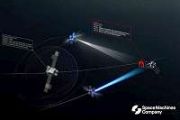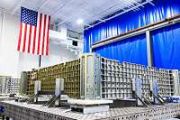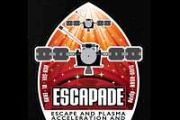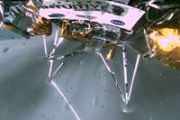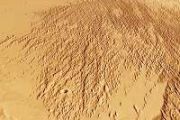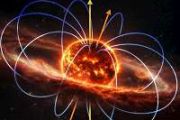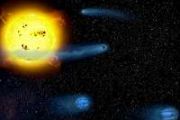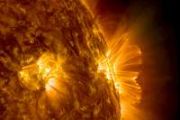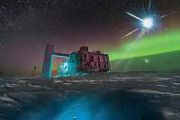
Copernical Team
Two US 'bumped' astronauts to return to Earth on Tuesday: NASA
 A pair of US astronauts stuck for more than nine months on the International Space Station will be returned to Earth on Tuesday evening, NASA said.
Butch Wilmore and Suni Williams are to be transported home with another American astronaut and a Russian cosmonaut aboard a SpaceX Crew Dragon craft, which arrived at the ISS early Sunday.
The stranded duo have been on the ISS since June aft
A pair of US astronauts stuck for more than nine months on the International Space Station will be returned to Earth on Tuesday evening, NASA said.
Butch Wilmore and Suni Williams are to be transported home with another American astronaut and a Russian cosmonaut aboard a SpaceX Crew Dragon craft, which arrived at the ISS early Sunday.
The stranded duo have been on the ISS since June aft Biomass out of the box
 Image:
Biomass out of the box
Image:
Biomass out of the box Sara García Alonso | Astronaut Reserve Training, Space biology, Explorer’s Wisdom | ESA Explores #10
 Video:
00:13:17
Video:
00:13:17
Meet Sara García Alonso — biotechnologist, cancer researcher, passionate science communicator and member of ESA’s Astronaut Reserve.
She’s our first guest in this miniseries, where we dive into the journey of the ESA Astronaut Reserve and explore the first part of their Astronaut Reserve Training (ART) at the European Astronaut Centre (EAC). Here, our “ARTists” are learning all about ESA and the International Space Station programme, the European space industry and institutions, and gaining hands-on experience in technical skills like spacecraft systems and robotics, as well as human behaviour, scientific lessons, scuba diving, and survival skills. This interview
Nearby Supernovae Linked to Two Ancient Earth Extinctions
 A recent study suggests that at least two of Earth's mass extinctions may have been triggered by the powerful effects of nearby supernova explosions. Researchers at Keele University propose that these cosmic blasts-marking the end of massive stars-could have stripped Earth's atmosphere of ozone, induced acid rain, and exposed life to harmful ultraviolet radiation from the Sun.
The study im
A recent study suggests that at least two of Earth's mass extinctions may have been triggered by the powerful effects of nearby supernova explosions. Researchers at Keele University propose that these cosmic blasts-marking the end of massive stars-could have stripped Earth's atmosphere of ozone, induced acid rain, and exposed life to harmful ultraviolet radiation from the Sun.
The study im Rivada and Amentum Collaborate to Enhance Secure Government Communications
 Amentum (NYSE: AMTM), a global leader in advanced engineering and technology solutions, has partnered with Rivada Space Networks to introduce an ultra-secure low Earth orbit (LEO) connectivity network tailored for critical U.S. government communications worldwide.
Rivada's Outernet represents a breakthrough in global communications, offering a unified, low-latency, point-to-point satellite
Amentum (NYSE: AMTM), a global leader in advanced engineering and technology solutions, has partnered with Rivada Space Networks to introduce an ultra-secure low Earth orbit (LEO) connectivity network tailored for critical U.S. government communications worldwide.
Rivada's Outernet represents a breakthrough in global communications, offering a unified, low-latency, point-to-point satellite ESA's Mobile Navigation Lab Tackles Arctic Interference Testing
 Above the Arctic Circle on Norway's Andoya Island, three ESA radionavigation engineers take a brief respite from their demanding mission, playing shuffleboard as sheep graze under the aurora borealis. Their task is a critical one: evaluating how navigation systems endure interference threats. Over five days, they amassed 100 terabytes of data, essential for fortifying the resilience of satellite
Above the Arctic Circle on Norway's Andoya Island, three ESA radionavigation engineers take a brief respite from their demanding mission, playing shuffleboard as sheep graze under the aurora borealis. Their task is a critical one: evaluating how navigation systems endure interference threats. Over five days, they amassed 100 terabytes of data, essential for fortifying the resilience of satellite Spire Global Secures $40 Million in Private Placement
 Spire Global, Inc. (NYSE: SPIR) has finalized a securities purchase agreement for a private placement, expected to generate approximately $40 million in gross proceeds for the company, prior to deducting associated fees and expenses. The transaction is anticipated to close on or around March 14, 2025, subject to customary closing conditions.
Under the terms of the agreement, Spire will iss
Spire Global, Inc. (NYSE: SPIR) has finalized a securities purchase agreement for a private placement, expected to generate approximately $40 million in gross proceeds for the company, prior to deducting associated fees and expenses. The transaction is anticipated to close on or around March 14, 2025, subject to customary closing conditions.
Under the terms of the agreement, Spire will iss Astronomers Reveal Detailed 3D Map of Cosmic Dust
 Observing distant stars and galaxies comes with a challenge: how much of what we see is affected by cosmic dust? The presence of interstellar dust clouds can make celestial objects appear redder and dimmer than they actually are, an effect known as reddening and extinction. To address this, two astronomers have created an intricate 3D map that provides an unprecedented view of dust distribution
Observing distant stars and galaxies comes with a challenge: how much of what we see is affected by cosmic dust? The presence of interstellar dust clouds can make celestial objects appear redder and dimmer than they actually are, an effect known as reddening and extinction. To address this, two astronomers have created an intricate 3D map that provides an unprecedented view of dust distribution Understanding gamma rays in our universe through StarBurst
 The U.S. Naval Research Laboratory (NRL), in partnership with NASA's Marshall Space Flight Center (MSFC), has developed StarBurst, a small satellite (SmallSat) instrument for NASA's StarBurst Multimessenger Pioneer mission, which will detect the emission of short gamma-ray bursts (GRBs), a key electromagnetic (EM) signature that will contribute to the understanding of neutron star (NS) mergers.
The U.S. Naval Research Laboratory (NRL), in partnership with NASA's Marshall Space Flight Center (MSFC), has developed StarBurst, a small satellite (SmallSat) instrument for NASA's StarBurst Multimessenger Pioneer mission, which will detect the emission of short gamma-ray bursts (GRBs), a key electromagnetic (EM) signature that will contribute to the understanding of neutron star (NS) mergers. Stargazers marvel at 'Blood Moon', rare total lunar eclipse
 Stargazers across a swathe of the world marvelled at a dramatic red "Blood Moon" during a rare total lunar eclipse in the early hours of Friday morning.
The celestial spectacle was visible in the Americas and Pacific and Atlantic oceans, as well as in the westernmost parts of Europe and Africa.
The phenomenon happens when the Sun, Earth and Moon line up, causing our planet to cast a gian
Stargazers across a swathe of the world marvelled at a dramatic red "Blood Moon" during a rare total lunar eclipse in the early hours of Friday morning.
The celestial spectacle was visible in the Americas and Pacific and Atlantic oceans, as well as in the westernmost parts of Europe and Africa.
The phenomenon happens when the Sun, Earth and Moon line up, causing our planet to cast a gian 

